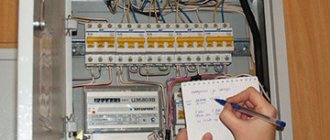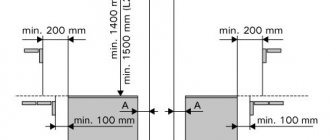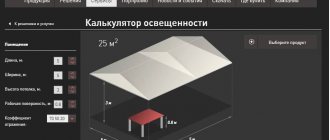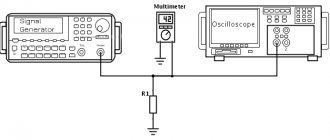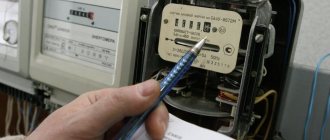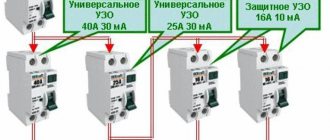It is necessary to transmit the data of an individual meter within a certain period of time. This ensures payment is calculated according to current tariffs. But in order to avoid discrepancies and errors, you need to correctly take the electricity meter readings. In fact, there is nothing complicated here, although not everyone knows where to look and which button to press to rewrite the necessary information.
Induction meters can be distinguished by a spinning wheel, which is located just below the frame with numbers. These numbers are the meter readings. The number of digits depends on the model.
How to take readings from an inductive and electronic electricity meter
How many numbers to write off
Typically, the induction meter display has 5, 6 or 7 digits. In most cases, the last digit, less often two, are separated by a comma, color, or differ in size. We do not take into account all numbers after the decimal point when taking readings . They show tenths and hundredths of a kilowatt and should not be taken into account. That is, we do not take into account all the numbers after the decimal point.
There are models with three “significant” digits and two after the decimal point
There are electricity meters that do not have decimal numbers. Then, when taking readings, write down all the numbers
But it is worth remembering that there are counter models that do not have a comma. In this case, when taking readings, you must write off all the numbers. If you don’t do this, sooner or later you will have to pay the difference, and it usually turns out to be very large. So be careful.
If you are unsure whether your meter has a comma, write down the model, name and call the customer service of the organization that supplies electricity. Let them clarify how many numbers in your case need to be written off when taking readings. You can also call an inspector to your home or check this data with the electrician of the management company.
How to shoot
Immediately after installing the meter, you were given a certificate in which the initial numbers are indicated. When you come to take readings from the light meter, take a piece of paper and copy down the current readings there (without taking into account the numbers separated by a comma). You can also not rewrite the zeros that appear at the beginning - up to the first digit (see photo).
Example of induction meter readings
For further calculations, data for the previous month is required. In the first month of use, you take them from the installation report, and in the future you need to either keep receipts or keep an accounting log. Where and how they will be stored is your choice.
Some subscriber services work in such a way that you don’t even need to count anything, you just need to transfer data within a certain period of time. Their automated system will write it to your personal account (or the operator will do it), then make the charges independently and generate a receipt. All you have to do is pay the invoice. But even in this case, for control, you can calculate how much you should pay for electricity yourself. Of course, it is unlikely that computers will make a mistake (they think), but you never know...
How to count
To calculate the electricity on the meter yourself, subtract the one that was there before from the number you just wrote. You get the number of kilowatts consumed over the last period.
For example, consider the readings in the photo above. Let the previous ones be 4852, the current ones 5101 (we ignore the numbers after the decimal point). We calculate the electricity consumption: 5101 - 4852 = 249 kW. To find out how much you need to pay, you need to multiply the resulting number of kilowatts (in this case 249 kW) by the tariff. Get the amount you have to pay for the light.
If the counter stands for a long time, sooner or later it will “reset to zero” - zeros will appear in the first positions. How to calculate electricity consumption in this case? Everything is very simple. This time you will have to rewrite the readings with all zeros, and put a “1” in front of the first one. For example, you asked to take readings from the meter, but only the last digits are different from zero. Or, as in the photo below, it costs only one.
After zeroing, there may be a picture like this, or there may be two digits other than zero, or three...
You rewrite the value as is, with all zeros (but we don’t write numbers after the decimal point), put a unit in front of the first zero, and then count as before. Let's count the readings in the photo. We write off the reading, putting “1” in front: 100001. Let the last reading be 99863. Subtract 100001 - 99863 = 138 kW. Total consumption for the reporting period was 138 kW. In the future, you write off the electric meter readings as before, without leading zeros and without substituting a unit.
Types of meters
Accounting for consumed electricity in all electrified premises is carried out using a special meter. Electric meters are different. For example, digital and induction (mechanical).
Induction counters are equipped with a mechanical dial. It consists of several closely spaced wheels. One full rotation of the wheel indicates that you have just used 1000 kilowatt-hours. These wheels are driven by a mechanical disc. You can also observe it in the glass window of the device. The faster the disk spins, the more electricity you are currently consuming. Mechanical meters have been proving their efficiency and resistance to voltage surges for decades. Perhaps your mechanical counter witnessed the thaw, perestroika and the birth of a new Russia. And it is possible that he could meet your grandchildren, but most likely in the coming years you will replace him for the sake of progress. If it hasn't already been replaced.
A young competitor to the mechanical counter is the electronic counter. These devices are more expensive than their mechanical counterparts. But their readings are unusually accurate, and some models can operate in two-phase mode (more on this below). Electronic meters show the amount of energy consumed in a special viewing window. They allow you to take readings remotely, store the history of readings in memory, and do not allow third-party interference in the system for the purpose of stealing kilowatts. But they can hardly survive power surges. When there are differences, electronic meters often fail, and their repair is expensive.
How to receive a receipt for payment?
If the payment was made at a bank branch, then the receipt will be issued by the cashier immediately after the funds are transferred. It bears the signature and seal of the bank. This point is the only convenience in the case of payment in a structural unit. When paying via an ATM/terminal, a corresponding receipt is also issued after the payment is made. Given the fact that such documents fade quickly, it is recommended to make a copy or photograph them. After making a payment in Sberbank Online, at the bottom of the screen there will be an option to print a receipt:
By clicking on it, the client automatically goes to the print menu. It should be noted that it is absolutely not necessary to have a printer for this. It is possible to save the receipt in PDF format. It can be either stored as a file or printed later. Moreover, if necessary, such a document can be “certified” at a bank branch by asking the manager to sign and stamp it.
Taking readings
To take readings from an electricity meter, you need to arm yourself with a notepad and pen. To avoid distortion, glare and incorrect angles, the meter dial should be exactly in front of your eyes. Write down the numbers to the decimal point, from left to right. Numbers after the decimal point are usually not included in receipts. They show tenths and hundredths of a kilowatt/hour. The numbers on the meter show the total energy consumed over all years of operation of the meter. The new counter will have zeros in the first few positions.
It is better to record readings at equal intervals. Most people find it convenient to receive this information on the first day of each month.
To calculate the electricity you spent for the month, you need to subtract from the previous readings those that you have now written out. The difference will indicate the number of kilowatts consumed. Then the resulting number should be multiplied by the current tariff - and behold, the amount is ready for payment. If the counter wheel is at a borderline value, select the lower number. You can also round the resulting number up for payment.
Norm of consumption of housing and communal services by Muscovites
From the beginning of 2022, the established consumption standards in the capital will remain the same. These indicators began to be applied in Moscow in July 2022 and will be valid until July 2022.
Since the summer, tariffs have increased by 5% compared to the first half of 2021.
Every year, the Government of the country recommends that regional authorities increase the cost of housing and communal services by at least the percentage typical for inflation. In addition, subjects have the right to make adjustments to the current values. As a standard, higher standards are established in the capital of the country . The reason is that every year the cost of work by resource supply companies increases.
According to the Decree of the Moscow Government of January 11, 1994 No. 41 “On the transition to a new payment system...” heating standards are established:
- consumption of thermal energy intended for heating the room - 0.016 Gcal/sq. m;
- water heating - 0.294 Gcal/person.
These indicators are used in a situation where there is no resource metering device installed in the room.
Gas standards
Also in the capital, separate gas standards are applied. They depend on the number of people living in the apartment.
Presented as follows:
- if a citizen lives alone and his living space is equipped with a gas stove, then the standard is 50 m³/person. per month;
- when a family lives in an apartment equipped with a gas stove – 45 m³/person. per month;
- if there is hot water supply in the living room - 8.3 m³/person. per month;
- if the apartment is equipped with a gas stove and water heater - 20.8 m³/person. per month;
- when there is no central water supply and there is a gas stove - 10.4 m³/person. per month.
The specified standards will also apply in a situation where the premises are not equipped with metering devices. When the house is not gasified, and the citizen uses a gas stove, there will be no need to pay for the resource in question.
Sewage standards in the capital
The standard water consumption in Moscow is reflected above, different for hot and cold. In this direction, one should take into account the provisions of Moscow Government Decree No. 41 dated January 11, 1994.
Depending on the level of equipment of a particular house with different communication systems, separate standard values are established. For example, if a residential building is equipped with sewerage, running water, a bathtub, and hot central water supply, the standard for wastewater disposal is 11.68 m³ per person per month. In this case, the standard per citizen for cold water is 6.935, for hot water - 4.745.
If the room has sewerage, running water and a bath with gas-type heaters:
- cold water supply - 9.86 m3 per citizen;
- water removal – 9.86.
If a water supply system with gas-type heaters for baths and sewers is installed in an apartment building, then the standards change. In this case, drainage and hot water supply is 9.49 m3 per person.
Please note: when a hotel-type residential building is considered, which is equipped with running water, hot water, and gas, the standards for wastewater disposal are 7.31 m3 per person, for cold water supply the figures are 4.386, for hot water supply - 2.924.
In a situation where an apartment building has a gas pipeline, sewerage, water supply, but no baths, the standard for water disposal is 4.57 m3 per person, for cold water supply - 4.57 m3. In addition, the permissible values are established relative to the personal plot policy, which are equal to 0.16 m3. This rule is valid from May to September.
Electricity consumption standards in capitals
For electricity, separate regulations also apply. These values also differ depending on what systems the MKD is equipped with.
Indicators used:
- if the apartment has a gas stove - 100 kW per person;
- availability of electric stove – 150 kW;
- when a water heater is installed - 120 kW;
- if both a water heater and an electric stove are used - 170 kW.
These values increase depending on how many citizens live in the apartment. However, the standards are reduced in proportion to the number of people living in the premises.
We transmit the testimony
In order to ensure that the receipt always contains up-to-date charges, the owners of the premises must promptly transfer data on energy consumption to the responsible organization. You can transfer counter data in several ways:
- If you have a lot of free time and need to communicate, you can personally visit the office of the energy company and provide the data personally to any available operator;
- Not all, but many energy sales companies have websites that have a feedback form with a field for meter readings;
- You can transfer the data to the operator by phone. But most likely, no one can vouch for the reliability of the received information;
- Enter the data in the box provided by the banking service. For example, when paying a receipt through Sberbank online, the payer enters all the necessary information in specially designated fields.
- Write down the testimony on the receipt in the appropriate column and pay it at the cash desk of a bank or post office.
How to create a template in Sberbank Online?
In order not to search for all the information and enter data again each time, you can save the payment in templates. To do this you need:
- Log in to Sberbank Online as described above.
- Make the payment in exactly the same way as described at the beginning of the article.
- At the stage of full payment, when information about a successful payment is displayed, find the “Create template” button and click on it.
- Enter a name for the template and save it.
Alternatively, you can create a template in another way:
- Log in to Sberbank Online.
- On the right side of the screen, find the “My Templates” section.
- Expand the list and click on the “Manage Templates” button.
- A new page will open with a list of all existing templates (if any). There is also a “Create template” button.
- Enter all required information.
- Confirm the fact of creation.
Tariffs for payment
The current rates are usually indicated on the receipt. If for some reason you don’t have a receipt yet, you can always call the city energy sales office and find out what the limits are for paying for electricity.
In a number of regions, since 2013, the cost of electricity for the population is calculated taking into account the so-called social consumption norm. What does this mean: experts have calculated how much electricity an average family with different composition should consume on average. This average value is taken as the norm. Those readings that fall within the established norm are paid at low rates. Indications above the norm are paid at an increased rate.
It is planned that all regions of Russia will switch to paying for electricity according to social standards by 2022.
The social norm depends on many parameters. The calculation of the norm is based on the following criteria:
- number of residents in the apartment;
- location of housing in the city or outside it;
- equipping living quarters with electric stoves for cooking;
- heating and water heating using electricity;
- classifying the housing stock as unsafe or dilapidated;
- availability of privileged categories of citizens in the apartment;
- introduction of seasonal adjustment factors to tariffs.
The value of the social norm and the amount of payment per kilowatt/hour are established by territorial tariff services; all information about tariffs can usually also be found on the regional government website.
What to do and how to calculate electricity without meter readings
Sometimes some malfunctions occur with the meter. In this case, you will not be able to pay for it until the problem is fixed, but there are several options for how to pay for electricity - this is time.
Payment for electricity when the meter malfunctions:
- Meter readings are presented to the electricity supplier. If you did not have time to present them on time, then for this month you will pay according to the average electricity consumption of your apartment. To do this, utility services will take readings from the documentation that you have provided for the last six months and provide the resulting indicator for payment.
- If your meter breaks down, then from the moment the device breaks down you will pay according to average indicators, which will be calculated based on the readings of the last six months. However, this tariff will only be valid for three months; if the problem with the meter is not resolved, then you will be subject to payments according to the standard.
- Periodically, energy sales representatives check the meter readings in the apartment. If you do not allow them within three months, then you will be transferred to payment according to the standards.
- In the event that you moderately break the meter, or conduct electricity from another apartment, then you will pay a receipt that will be drawn up for you by an energy sales representative, and all the appliances in your house will be included in it as if they were constantly working.
Thus, it is better to monitor your meter, and if it breaks down, contact the utility services in a timely manner. Otherwise you may have problems.
General house electricity consumption
Residents of apartment buildings pay not only for electricity consumed within the apartment. Payments must also be made for the operation of the elevator, access lights, intercom and other electrical appliances in a residential building. And here two situations occur. In one of them, an apartment building is equipped with a common building meter. The device calculates how much electricity was spent to ensure the functioning of common property and the local area. The meter readings are recorded, transferred to the receipt, and the amount to be paid is calculated. After this, the resulting amount is divided among all residents of the house.
The amount can be divided equally by the number of apartments, or in proportion to the occupied share of the apartment in the total area of the entire house. The calculation method and tariff for payment must be stipulated in the agreement between residents and the management organization.
In the second case, a common electricity meter is not installed in the house. In such situations, a special tariff is implemented for premises not equipped with metering devices. Standards are also set by regional authorities. To ensure that citizens do not hesitate to install a meter, in some cases increasing coefficients are applied to standard tariffs. Usually, if the house does not have a general electricity meter, the functions of collecting readings are assigned to employees of the management company.
In order to avoid setting unjustified tariffs for electricity consumed for general household needs, current legislation prohibits the establishment of tariffs that exceed the existing regional norm.
Standards used when paying for housing and utilities
In 2022, the social standard for room area will be used to calculate and provide preferences for payment for utilities and heating. These rules apply to situations where legal acts stipulate that benefits are determined taking into account social standards .
The table shows the applied values:
| Number of residents | Norm |
| Citizen lives alone | 33 square meters of total area |
| The family consists of two persons | 42 square |
| Three or more citizens in a family | 18 squares for each |
The specified standard for the size of the premises, taken into account when calculating payments for housing and communal services, was developed by Decree of the Moscow Government No. 306 of 2006 “On approval of the Rules...”.
Water consumption standards in 2022 in the capital
To pay for utility services, the standards set out in the above-mentioned Resolution are applied. In a situation where the premises are equipped with metering devices, their readings are used to calculate payment.
Amounts spent on general house needs are distributed among the owners of all apartments. The size of a specific housing is taken into account in proportion to the total area of the house. In a situation where the apartment is not equipped with metering devices, the calculation is made on the basis of standards. Similar rules apply to the calculation of the amount for common property, and it is subject to division between everyone equally.
These provisions are reflected in Government Decree No. 129 of 2015 “On Amendments...”.
Without a meter, payment is charged at an increased rate, which applies to a situation where a citizen is responsible for installing the device in question.
cold water standards are currently applied , presented as 6.935 m3 per person per month. For hot water, the specified norm is 4.745 m3 per citizen. If the volume of consumption is determined without metering devices, the calculated value is subject to increase by the amount of consumption for general household needs.
Important! Decree of the Moscow Government of 2014 No. 75-PP indicates that the total volume of water use in housing not equipped with metering devices cannot be more than the approved standards per person, multiplied by 2.
Features of operation of multi-tariff meters
The increase in the overall load on the electrical grid occurs at the same time - when people are going to work/school, and when people from there return and start using all their appliances. On weekends and holidays, the load also increases significantly.
To distribute the load more evenly, energy companies are actively promoting multi-tariff meters. Currently, there are two- and three-phase devices. The principle of their operation is quite simple. At night, the cost of electricity consumption decreases significantly, and during the day or peak time it remains the same or increases slightly.
These meters are not cheap. However, people who installed them claim that the device pays for itself very quickly. This purchase will be especially beneficial for owners of houses that use electricity-based heating.
So, two-phase meters divide electricity consumption into two categories. From 7 am to 11 pm there is an “expensive” daily rate. From 23-00 to 7-00 respectively - cheap night prices. The logic is simple. Dishwashers, washing machines and many other appliances can work well at night, significantly reducing the load on the network. The monetary savings are also significant.
Three-phase meters divide the day into the following tariffs:
- peak (from 7:00 to 10:00, and from 17:00 to 21:00)
- half-peak (from 10:00 to 17:00)
- night rate (from 21:00 to 7:00)
This division is even more beneficial for the consumer, since the cheap night tariff starts at 21-00, and not at 23-00, like with a two-phase meter.
How is a three-phase meter calculated?
Distinguish between three-phase
and a single-phase
meter
is very simple - just pay attention to how many wires are connected to the device: if 3 or less, the device operates on one phase;
if more than 3 – the device is three-phase
.
Interesting materials:
When can you go on vacation when applying for a job? When can noisy work begin? When can you not go to work? When can you go on vacation at your new job? When can noisy work be carried out in an apartment in Moscow? When can I return to work after dismissal? When is Medical Worker Day celebrated? When is Trade Worker's Day celebrated? When is Road Workers Day celebrated? When to transfer personal income tax when dismissing an employee?

